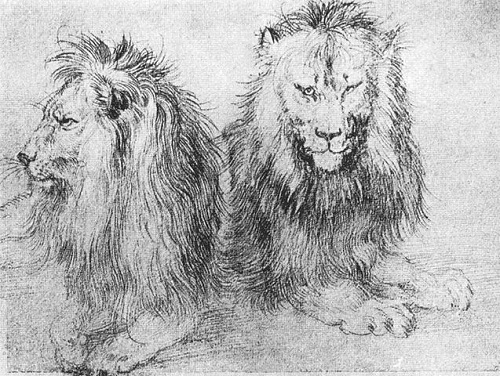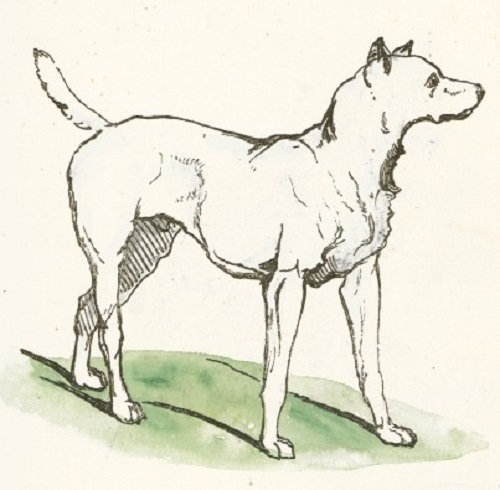The Difference between Sketch and Drawing

Durer lions (sketch)
The artists of this world, who work in all sorts of creative mediums, will tell you there is a distinct difference between the form and the relative use of a sketch and a drawing. The man in the street will see these two words and concepts as very similar. The mood surrounding a sketch and a drawing will probably put each medium into perspective. Sketching is a quick record of a moment or a reminder of something to be developed further. A drawing is more detailed and ultimately becomes the finished work. Understanding these two words fully will enable the differences to be more evident. Although they are generally attributed to the artistic field the use of the words sketch and drawing also reflect aspects of society.
What is a sketch?
Generally speaking a sketch is a loose, unrefined early inspiration towards a final drawing. Sketches lack detail and have many lines that are part of the visual image. They give the artist the opportunity to experiment with perspective and proportion. The sketch is the first draft of the final work. Sketches are developed in shades of light and dark, they are a casual way of capturing the essence of the picture. A reference to the development of the final work, the sketch is the artist’s inspiration after deciding on the topic for his creation. Sketches are worked in charcoal, pencil and monochrome media like ink. Although sketches are not considered to be the finished work there are some sketches attributed to famous artists that have become prized works of art. The sketch books of Leonardo Da Vinci and Edgar Degas for example have become very valuable. A sketch of Leonardo Da Vinci’s found and sold in 2016 fetched the record price of $16 million.
Sketches can also make their way into our social media as they become part of different ways of describing other activities.
A sketch can be a way of describing someone or some activity using just a few words. There can be a sketchy description of an event for instance. They can also be drafts or early designs of things to come. A book for example may have a sketch of the plot prior to writing the story in detail.
In the dramatic world a sketch can be a brief musical or literary review. It could be a satirical part of a play scene or a skit of some sort just providing a short or brief glimpse of the real story. Sketches have become part of the courtroom scene. An artist will sit in court and sketch the faces of the people involved in the court case. Recording the animated expressions from the judge to the jury has become part of the courtroom drama. The sketches add to the understanding of the event as well as recording images of the accused and other persons involved in the case. Sketches known as ‘composite sketches’ can help in criminal investigations as the image of the offender or a witness may be sketched according to the description given. This is especially helpful if there is no real witness to the crime and a sketch of what someone saw briefly can often help to find the offender.
Urban sketchers are an interesting group of artists who like to sketch life in the city or places they see on their travels. There is an organisation called ‘Urban Sketchers’ who, by invitation, have a group of one hundred sketchers. This select group encourage one another and exhibit each other’s work on social media platforms they only exhibit the work of the sketchers who belong to their selected artists.
Grammar and parts of speech that describe sketch and help to be more familiar with the word.
Sketch as a noun: The sketch is the object, the picture drawn by the artist.
Using sketch as a noun: Leonardo Da Vinci is known for his wonderful sketches which have become as valuable as some of his paintings.
Sketch as a verb: the act of putting together a sketch, sketching.
The artist drew a sketch of the farmhouse before he started the picture he was going to paint.
Sketch/sketchy as an adjective: the way something looks after the sketch is complete or after a description of something.
Using sketch as an adjective: The witness gave a sketchy description of the burglar to the police officer at the police station.
Idioms using the word sketch.
‘Keeping sketch’ means keeping a lookout.
The young boy was ‘keeping sketch’ for his older brother while he tried to take an apple from the farmer’s orchard.
A thumbnail sketch is the way of describing a very small sketch or idea mapped out with minimum detail. It just gives the idea of what is to be shared about another person, place or thing.
Sketches can be put on all kinds of paper, even poor quality paper. Artists use sketch books for recording their sketches and sketches lay the foundation for drawings and other works of art. A sculptor will make 3D sketches in clay, plasticine or wax.
Fernando Botero, a Columbia artist and sculptor said:
“Sketching is almost everything. It is the painter’s identity, his style, his conviction and then colour is just a gift to the drawing.”
Botero describes the link in the artistic world to the process of making a sketch and then the final work of art, the drawing with the addition of colour. This is then the painting – the final creation complete. However, it is true to say that a sketch and a drawing can be two stand-alone pieces of work especially if you have become a world famous artist.

Simple Dog Drawing
What is a drawing and how does it differ from a sketch?
A drawing is a more detailed approach to creating a picture and the drawing becomes the finished piece of work. Drawings use pencil crayons, graphite pencils pastels and other monochrome mediums. Sometimes artists call drawings ‘studies’ as they look in more detail at the final picture. Drawing can be the outcome of a sketch as the artist uses the sketch for guidance and the initial study of the subject matter.
The artist Degas said “Drawing is not what one sees but what one can make others see.”
Drawings use heavier paper as a better depth of colour and texture are achieved on better quality paper. Drawings usually get to be framed and displayed as they are a more detailed piece of work.
There are more idioms attached to the use of the word drawing and different uses or interpretations of the word. You can pull or draw something and you may draw water from a well or draw out a winning lottery ticket. However in the context of drawing as an artist, the drawing is a piece of artwork.
Interesting idiomatic examples are:
- Drawing a blank is to not understand something.
- Drawing a line between two things is to define or distinguish between two things.
- Drawing blood refers to the act of making someone bleed.
- Drawing someone out refers to asking questions and getting answers from someone.
- Drawing fire away is creating a distraction and taking the focus away from someone.
- Drawing something to a close is finalising something.
Drawing is not without synonyms and antonyms that add to the understanding of the word.
Synonyms chosen are: depict, gather, delineate, pull,
Antonyms chosen are: reject, abbreviate, and transfer.
Drawing, like sketching can be used as a noun when it is the article of work. It can also be a verb, the act of drawing.
Drawings are not confined to the realm of the artist and are used extensively by architects and draftsmen. The architect draws the plans and the draftsman drafts the project too. In modern technology many architects’ plans are designed digitally using sophisticated computer programmes. Maps are also recorded through drawings and today most maps are produced digitally. However there is still room for that friendly hand drawn map giving visitor directions to your house.
In the final analysis Degas says:
‘Drawing is the artists most direct and spontaneous expression a species of writing: it reveals, better than does a painting, his true personality.”
A quotation like this puts the artist and his drawings in broader world of creativity. It is where the drawing is not only the visual craft but also one of the moods and emotions of the artist expressed visually through the drawing. The sketch is an integral part of this expression but would only give a glimpse of the artist’s personal journey as it is only a pre-cursor to the final expression of artist.
- Difference Between Lagoon and Bay - October 20, 2021
- Difference Between Futurism and Preterism - August 12, 2021
- Difference Between Dichotomy and Paradox - August 7, 2021
Search DifferenceBetween.net :
1 Comment
Leave a Response
References :
[0]www.wordhippo.com
[1]www.oxfordlearnersdictionaries.com
[2]www.thesaurus.com
[3]www.wikipedia.com
[4]www.thoughtco.com
[5]www.thedrawingsource.com
[6]https://en.wikipedia.org/wiki/File:Durer_lions_(sketch).jpg
[7]https://commons.wikimedia.org/wiki/File:Simple_Dog_Drawing.jpg

Dear Christina,
Thank you for your clear explanation of the difference between “draw” and “sketch”. I know your aim was to explain this difference from an artistic or even technical viewpoint. From a linguistic viewpoint, however, I was surprised to see “The artist drew a sketch” as an example of “sketch” used as a verb. A verb must have a noun or pronoun subject, as in “I sketch” or “Jane sketches” or “We are sketching” or “The children sketched” etc. The combination: “a sketch” is definitely a noun, not a verb. I hope you don’t mind me pointing out this little linguistic quibble. SBurford